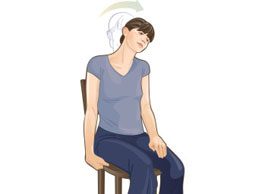
Upper trapezius stretch
More than 25 percent of the population experiences neck pain-and it’s more common in women than men. To fend off this ache, try stretching your trapezius-the kite-shaped muscle that covers the upper and back part of the neck and the shoulders-a few times a day.
Stretch: Sitting up straight, with your feet flat and shoulders back, grab onto the bottom of your chair with your right hand. Then slowly tilt your head sideways, bringing your left ear toward your left shoulder until you feel a gentle stretch along the right side of your neck and shoulder. Hold for 10 to 15 seconds; repeat on the opposite side. Do this stretch a few times a day to help prevent a strain from starting in the first place.
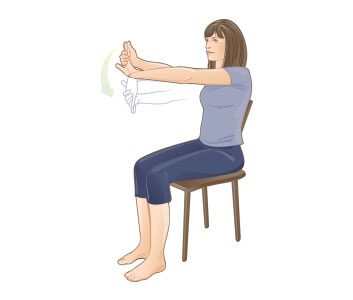
Wrist flexor stretch
Overuse injuries of the wrist are pretty common, and tend to affect people between the ages of 30 and 50. They can be caused at work or at play by repetitive gripping and grasping movements.
Stretch: While seated, extend your right arm forward at shoulder height. Keeping your elbow straight, grasp your right hand with your left, and slowly bend the wrist backward until you feel a stretch along the bottom of your forearm. Hold for 15 seconds. Then bend wrist downward until a stretch is felt on the top of the arm, and hold for 15 seconds. Switch arms and repeat. Repeat four times for each hand.
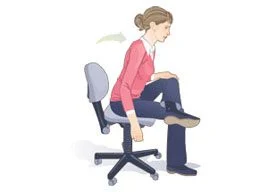
Seated glute stretch
For runners and walkers, stretching the gluteus maximus (butt muscles) improves flexibility and can help prevent injuries.
Stretch: Sit on a chair; bring one ankle up onto the knee of your other leg. Lean forward, keeping your back straight, and you should immediately feel the stretch in the gluteus maximus. Hold for 16 seconds. Continue forward as far as you can comfortably go, pushing gently on the top knee with your hand. Hold for 30 seconds, then switch sides.
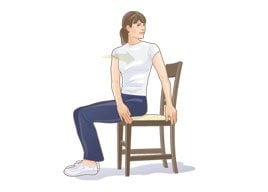
Low-back rotation stretch
This stretch targets the supportive soft tissues of the lumbar and thoracic spine. Try to get into the habit of doing it at least once an hour, in addition to getting up for a walk periodically.
Stretch: Sitting on a chair with your feet flat on the floor, twist your upper body so your shoulders rotate to one side. You can use the chair for support, holding on to get a deep muscle stretch. Go only as far as you can comfortably. You will feel the pull from your lower back up to the middle of your back. Hold for 20 seconds or six breaths, and return to the starting position. Repeat on the other side.
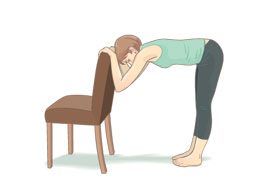
Hamstring stretch with chair
Hamstrings can easily be injured if they are not stretched, especially if you sit for long periods of time.
Stretch: Position yourself about a foot and a half (half a metre) behind a chair. Stand up straight, with your shoulders back and feet pointing forward. Keep your knees straight, but not locked. Keeping your neck aligned with your back throughout this move, bend at the hips to a 90-degree angle. (You may need to move the chair forward so you are putting the weight of your body on the chair and not holding yourself up-you’ll feel the stretch more this way.) Hold for 30 seconds.
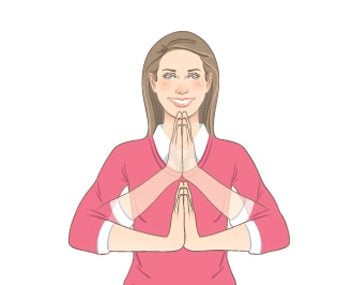
Prayer stretch
You probably don’t often think about stretching your wrists, but it’s important for maintaining good circulation.
Stretch: Place palms together, fingers straight, in a prayer position, elbows pointed out to your sides. Keeping the heels of the hands together, slowly lower hands and raise elbows so the angle at the wrist decreases. Press palms and fingers together firmly for five seconds, then release. Repeat five times.
Seated chest stretch
Our bodies were not designed to sit all day, yet that’s exactly what many Canadians do. his can lead to problems, including blood and nerve restriction in the arms; headaches; and back pain.
Stretch: Sitting at your desk, rotate your body so you are facing right. (This stretch can also be modified to a standing stretch using the wall as a stabilizer.) Raise your right arm, bending the elbow at 90 degrees, aligning elbow with shoulder, keeping the joints in a straight line and palm open. Sitting tall through your spine, rest your elbow lightly against the chair’s back and slowly rotate left. Hold this position for five slow, deep breaths; repeat on the other side.
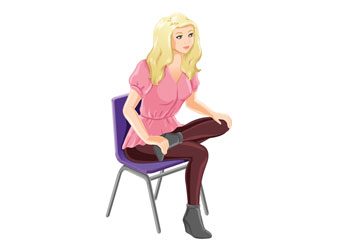
Office hip stretch
Doing this stretch will decrease your risk of lower back and sciatic pain. And the flexibility you’ll gain in your legs and hips will make it easier to do simple tasks such as bending forward to pick something up.
Stretch: Sitting at your desk, cross your right foot over your left knee, extending the left leg out a little if necessary. Keeping your right foot flexed to protect the ankle, lift the upper body tall, then hinge forward at the hips with a flat back. Hold the stretch for several deep breaths, lengthening the outer hip muscles. Repeat on the other side.
